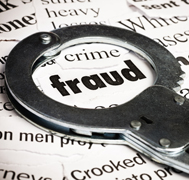
Mortgage fraud is a lender’s worst nightmare. Lending is your bread and butter, so you need to be vigilant when it comes to detecting mortgage fraud.
Ultimately, your institution will be the one impacted when a fraudulent transaction makes it past your scrutiny. The chances of recuperating money from a fraudulent deal are often slim to none. That’s why it pays to exercise due diligence using the most accurate and current information available before lending.
The Canada Mortgage and Housing Corporation (CMHC) defines mortgage fraud as knowingly misrepresenting information in order to secure mortgage financing. This includes
- inflating income
- misrepresenting the amount and/or source of a down payment
- not disclosing existing mortgage and/or debt obligations
- straw buyers: someone who agrees to sign an application on behalf of someone else
Is mortgage fraud as pervasive as we think? Are we being overly-cautious? We don’t believe so, but there seem to be mixed opinions on the topic. For example, CMHC’s Chief Executive Officer recently claimed in a Reuters Canada article that fraud isn’t a widespread problem within the industry while a recent Globe and Mail article highlighted that mortgage fraud is booming in Canada’s rapidly growing housing market.
In the same breath, the CMHC also announced that, at the direction of the federal government, they were working on improving their detection process.
Using data analysis to help catch fraud, CMHC can look at a larger volume of applications versus focusing on fraud detection with each individual application. With a larger dataset, this will help CMHC spot networks of fraud and find associations that might not be apparent by looking at individual applications. If CMHC is looking at this – why can’t you? In fact, much of the data they use is available to you too.
On the rise or not, fraud still happens, and because there are so many people involved in a real estate transaction, it can be difficult to detect sometimes without access to the right tools and information. Sometimes applicants may not even be aware that they may be committing fraud by omission, for example. Or let’s say an applicant ‘guesstimates’ their salary instead of providing an accurate income – that’s another instance of fraud without knowingly committing it. That’s why independently validating information is critical.
With years of skyrocketing prices, fierce competition, and tighter federal mortgage lending rules, there are incentives to both fraudsters and those who simply have a dream to own their home to abuse the system. By asking the right questions and leveraging the latest technology, it’s easier to spot fraud.
Here are a few measures that can be revealed with a detailed property search, for example:
- new housing expense exceeds 50 percent of current housing expense
- information on application inconsistent with other loan documents
- photos do not match description of property
- additional properties listed but not on loan application
If you want to increase the chances of preventing fraud, you need to independently verify applicant information. This sort of independent verification is made easy with the online tools from. Fraud Check is a Purview tool that scans for information that may indicate the need to look more deeply into a transaction. Furthermore, you can use an automated valuation model to validate information like a property’s value, home ownership, registered mortgages and more.
Find out how Purview can help you mitigate mortgage fraud. Call us today at 1.855.787.8439 or visit: www.purview.ca.
Sources:
http://ca.reuters.com/article/domesticNews/idCAKBN18S5WN-OCADN






